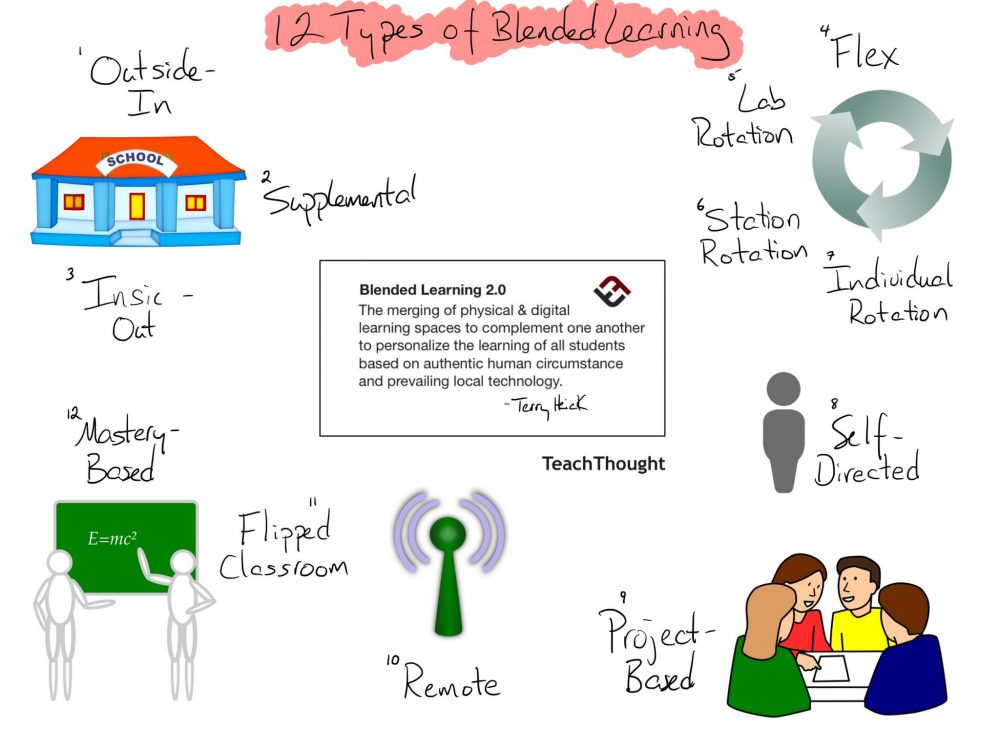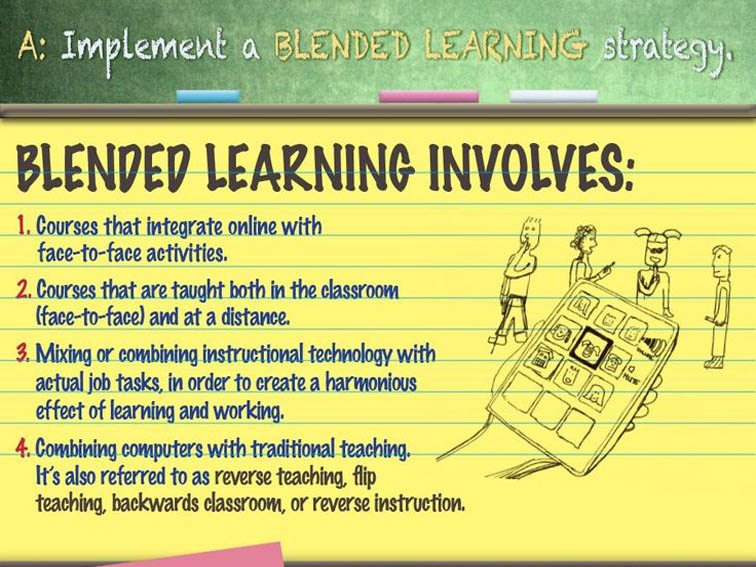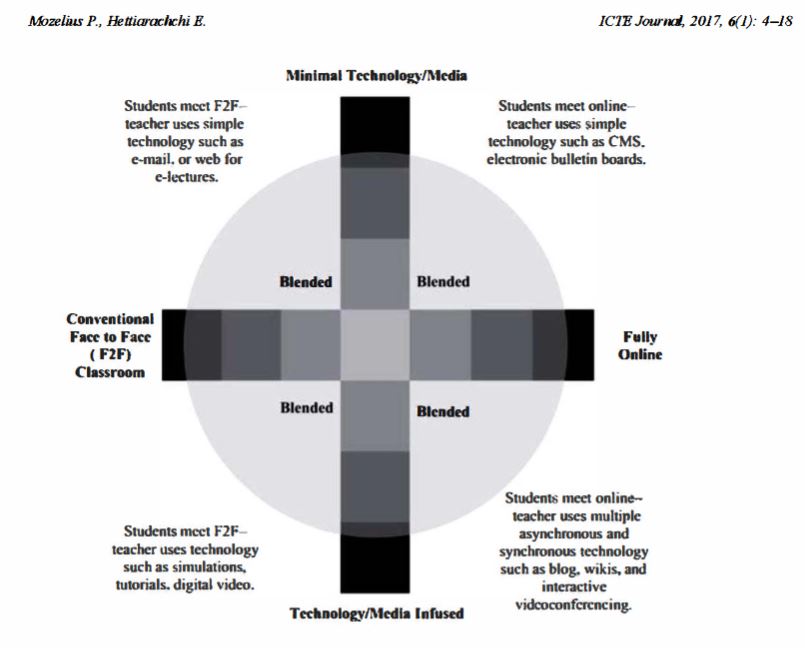Searching for "blended learning"
Find The Model That Works For You: 12 Types Of Blended Learning
Find The Model That Works For You: 12 Types Of Blended Learning


+++++++++++++
more on blended learning in this IMS blog
https://blog.stcloudstate.edu/ims?s=blended+learning
Critical Factors for Implementing Blended Learning in Higher Education.
Available from: https://www.researchgate.net/publication/318191000_Critical_Factors_for_Implementing_Blended_Learning_in_Higher_Education [accessed Jul 6, 2017].
Definition of Blended learning
Blended learning is in one dimension broadly defined as “The convergence of online and face-to-face Education” as in the study by Watson (2008). At the same time it is important to also include the dimension of technology and media use as it has been depicted in the multimodal conceptual model in Figure 1 below. This conceptual model was proposed and presented in an article published by Picciano (2009). Critical Factors for Implementing Blended Learning in Higher Education.

online face to face hybrid
Several studies that argue for the need to focus on pedagogy and learning objectives and not solely on technology (Hoffinan, 2006; Garrison & Vaughan, 2008; Al amm ary et al., 2014; McGee & Reis, 2012; Shand, Glassett Farrelly & Costa, 2016). Other findings in this study are that technology still is a critical issue (So & Brush, 2008; Fleming, Becker & Newton, 2017), not least in developing regions (AI Busaidi & Al-Shihi, 2012; Raphae1 & Mtebe, 2016), and also the more positive idea of technology as a supporting factor for innovative didactics and instructional design to satisfy the needs in heterogeneous student groups (Picciano, 2009). Critical Factors for Implementing Blended Learning in Higher Education.
Critical factors:
- technology
- didactics – pedagogy, instructional design and the teacher role
- Course outcomes – learning outcomes and learner satisfaction
- collaboration and social presence
- course design
- the heritage from technology enhanced distance courses
- multimodal overload
- trends and hypes
- economy
Blended learning perspectives
- the university perspective
- the Learner perspective
- the Teacher perspective
- the Global perspective
++++++++++++++++++++
more on blended learning in this IMS blog
https://blog.stcloudstate.edu/ims?s=blended+learning
Dr. Baiyun Chen, OLC Institute faculty for the Blended Learning Mastery Series: Research into Practice, joins us to discuss the future of blended learning in higher education
Insights from the Field: The Future of Blended Learning
The design of blended learning curriculum will be more diversified and personalized with the integration of creative in-class active learning strategies and innovative educational technologies, such as adaptive learning, virtual reality, mobile technologies
Quality assurance is the biggest challenge with implementing blended learning in the higher education environment today. I would propose institutions to adopt evidence-based standards for course evaluations. For instance, the OLC Quality Scorecard for Blended Learning Programs
+++++++++++++++++++
more on blended learning in this IMS blog
https://blog.stcloudstate.edu/ims?s=blended+learning
The Definition Of Blended Learning
January 18, 2013 http://www.teachthought.com/learning/blended-flipped-learning/the-definition-of-blended-learning/
the Sloan Consortium defined hybrid courses as those that “integrate online with traditional face-to-face class activities in a planned, pedagogically valuable manner.” Educators probably disagree on what qualifies as “pedagogically valuable,” but the essence is clear: Hybrid education uses online technology to not just supplement, but transform and improve the learning process.
++++++++++++++++++
more on blended / hybrid learning in this IMS blog
https://blog.stcloudstate.edu/ims?s=blended
https://blog.stcloudstate.edu/ims?s=blended+learning

+++++++++++++++++++++++
more on blended / hybrid learning in this IMS blog
https://blog.stcloudstate.edu/ims?s=blended
https://www.pinterest.com/pin/175499716709819945
http://www.gettingsmart.com/2013/09/120-top-articles-on-blended-learning/
125 Top Blogs on Blended Learning
++++++++++++++++
more on blended learning in this IMS blog
https://blog.stcloudstate.edu/ims?s=blended+learning
https://www.pinterest.com/pin/180073685080753333/sent/?sender=122441821027571715&invite_code=fb43268866cc952ca75f134d842b8a82

++++++++++++++++++++
more on blended learning in this IMS blog
https://blog.stcloudstate.edu/ims?s=blended+learning
http://elearninginfographics.com/10-blended-learning-trends-infographic/

_++++++++++++++++++++
more on blended learning in this IMS blog
https://blog.stcloudstate.edu/ims?s=blended+learning
Save
Discussion on the EDUCAUSE Blended and Online Learning Group’s listserv
Question:\
I head an instructional design unit and we’ve been noticing that instructors with no experience in online teaching seem to struggle to teach in a blended environment. They get easily confused about 1) how to decide what content is best suited for in class and what goes online and 2) they also have difficulty bridging the two modalities to create a seamless and rich learning environment.
Rema Nilakanta, Ph.D., Director of Design and Delivery Engineering-LAS Online Learning 1328 Howe Hall 537 Bissell Rd P 515-294-9259 F 515-294-6184 W http://www.elo.iastate.edu
Answers:
Oregon State University has a hybrid course design program that is a partnership between OSU’s Ecampus and our Center for Teaching and Learning. You can find quite a few resources here: http://ctl.oregonstate.edu/hybrid-learning
Shannon Riggs Director, Course Development and Training Oregon State University Ecampus 4943 Valley Library Corvallis, OR 97331-4504 541.737.2613
+++++++++++++++++
http://onlinelearningconsortium.org/consult/olc-quality-scorecard-blended-learning-programs/
Jennifer Mathes, Ph.D. Director of Strategic Partnerships Online Learning Consortium Office: (781) 583-7571 Mobile: (913) 226-4977 Email: jennifer.mathes@onlinelearning-c.org Website: http://www.onlinelearning-c.org Skype: mathes.olc
+++++++++++++++
You might find my recent book The Blended Course Design Workbook: A Practical Guide to be a helpful resource. Each chapter has a literature review of the relevant research as well as activities to guide faculty through the various components of blended course design. You can read the first chapter on the fundamentals of blended teaching and learning at the publisher website. The book also has a companion website with additional resources here: http://www.bcdworkbook.com.
Katie Linder Research Director Extended Campus, Oregon State University 4943 The Valley Library Corvallis, Oregon 97331 Phone 541-737-4629 | Fax 541-737-2734 Email: kathryn.linder@oregonstate.edu Twitter: @ECResearchUnit & @RIA_podcast Check out the Research in Action podcast: ecampus.oregonstate.edu/podcast
+++++++++++
more on blended learning in this IMS blog:
https://blog.stcloudstate.edu/ims?s=blended+learning
International Journal of Mobile and Blended Learning (IJMBL)
Editor-in-Chief: David Parsons (The Mind Lab by Unitec, New Zealand)
Published Quarterly. Est. 2009.
ISSN: 1941-8647|EISSN: 1941-8655|DOI: 10.4018/IJMBL
Description
The International Journal of Mobile and Blended Learning (IJMBL) provides a forum for researchers in this field to share their knowledge and experience of combining e-learning and m-learning with other educational resources. Providing researchers, practitioners, and academicians with insight into a wide range of topics such as knowledge sharing, mobile games for learning, collaborative learning, and e-learning, this journal contains useful articles for those seeking to learn, analyze, improve, and apply technologies in mobile and blended learning. The journal spans theoretical, technical, and pedagogical issues in mobile and blended learning. These embrace comprehensive or critical reviews of the current literature, relevant technologies and applications, and important contextual issues such as privacy, security, adaptivity, and resource constraints.
Topics Covered
- Comprehensive or critical reviews of the current literature
- Evaluation of mobile or blended learning in practice
- Future of mobile or blended learning
- Knowledge Sharing
- Learner interaction/collaborative learning
- Mobile games for learning
- Mobile or blended learning applications
- Mobile or blended learning applied at different levels of education from pre-school to tertiary and beyond
- Pedagogical and/or philosophical underpinnings of mobile or blended learning
- Privacy and security issues
- Related research in learning, including e-learning and pedagogical approaches
- Resource constraints in the delivery of mobile or blended learning
- Reviews of the application of mobile or blended learning in multiple contexts
- Role of Wikis, blogs, podcasts, messaging, other online tools, and Web 2.0 components in learning delivery
- Roles of mobile, pervasive, and immersive technologies in education
- Technologies that directly or indirectly support mobile or blended learning systems (devices, networks, tools etc.)
- Theoretical approaches to mobile or blended learning solutions
- Use of mobile or blended learning in professional environments
Mission
The primary mission of the International Journal of Mobile and Blended Learning (IJMBL) is to provide comprehensive coverage and understanding of the role of innovative learning theory and practice in an increasingly mobile and pervasive technological environment. As technology enables a more seamless experience of device supported learning worlds that may integrate mobile, embedded, augmented, and immersive technologies, we may expect to see increasing interest and activity in blended approaches to learning. IJMBL brings together researchers at the forefront of this field, in both technology and pedagogical practice and assists them in the development and dissemination of new approaches to both mobile and blended learning.
+++++++++++++++++++++
More on mobile and blended learning in this IMS blog:
https://blog.stcloudstate.edu/ims?s=mobile+learning
https://blog.stcloudstate.edu/ims?s=blended+learning





